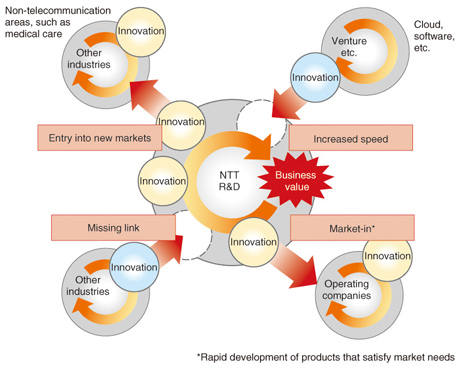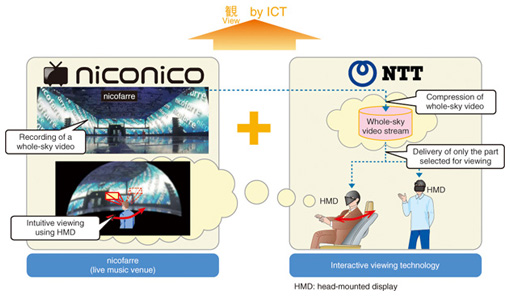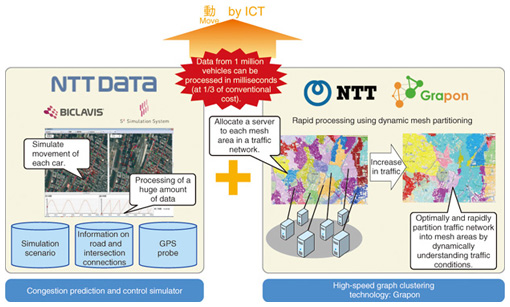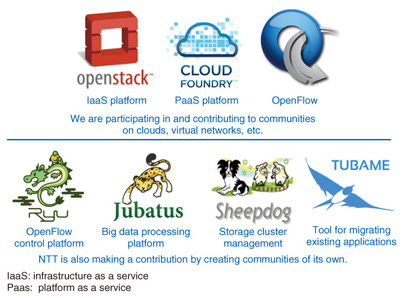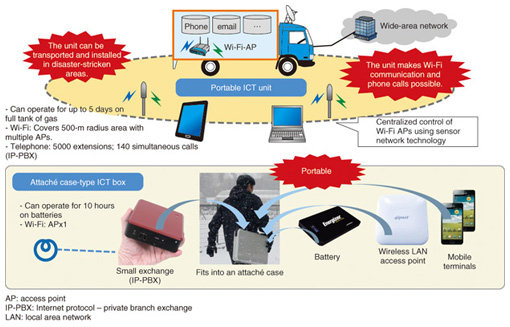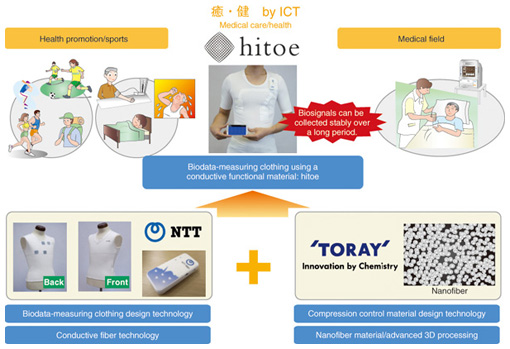 |
|
|
|
|
|
Feature Articles: Keynote Speeches at NTT R&D Forum 2014 Vol. 12, No. 4, pp. 9–21, Apr. 2014. https://doi.org/10.53829/ntr201404fa2 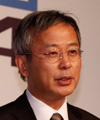 Co-innovation ChallengesAbstractNTT aims to enhance the comfort and quality of life of people by exploiting information and communications technology (ICT). This article introduces NTT’s research and development (R&D) activities to achieve innovation through various collaborations. It is based on the keynote speech delivered by Hiromichi Shinohara, Director and Executive Vice President, Director of Research and Development Planning Department, NTT, at the NTT R&D Forum 2014 held on February 13–14, 2014. Keywords: co-innovation, ICT, R&D 1. NTT R&D (research and development) design for tomorrow’s world1.1 Advances in ICT and the role of the NTT GroupThe role of telecommunication carriers used to be connecting people to people. The goal was primarily to provide connections rapidly at any time. However, in the last two decades, the role of connecting people with information has been added. It has become important to deliver vast amounts of information to customers at high speed. The NTT Group believes that it needs to take this trend a step further. It wishes to transform its role to one of enabling those in a variety of fields and industries to enhance their value, through the provision of information and communications technology (ICT) (Fig. 1).
Before we look to the future, let us first look back at how technology and everyday life have evolved. The computing power of super computers in the 1980s was roughly equivalent to that found in today’s CPU for mobile devices. A 20-GB storage unit weighed 2 tons then and cost about 100 million yen. Today, the same amount of storage can be provided with a device weighing 0.5 g for just a few thousand yen. While technology has advanced dramatically, our everyday life and social activities do not seem to have kept pace. Instead of looking at progress in technology and thinking how it can change society, it is time to undertake technical development with the aim of realizing the forms of everyday life and the kinds of social activities that we want to create. 1.2 Activities that look to the futureIn the years to come, Japan will see both its total population and productive population shrink. The decline in the birthrate and the aging of the population will continue unabated. It is necessary to create a society in Japan that empowers foreigners, women, and the elderly. Everyone at the NTT laboratories believes that it is important to harness ICT to promote the comfort and quality of life of society at large. Allow me to introduce the activities that the researchers at the NTT laboratories believe they should undertake in order to realize a prosperous and healthy society, using the Japanese characters 安 (safety), 報 (inform), 健 (health), 癒 (medical care), etc. as keywords (Fig. 2).
(1) 安 (Safety) Let us look at ICT application examples from the viewpoint of safety and security (Fig. 3). These days, cyber-attacks have become a serious social problem, and it is therefore becoming increasingly important to prevent attacks in cyberspace. At the NTT laboratories, it is regarded as vital to find ways of preventing various actions that threaten our lives. These include not only attacks that take place in cyberspace but also those that alter real structures or cause them to fail or malfunction. It is therefore necessary to develop predictive security technology that detects early signs of accidents and other problems by, for example, using sensors or similar devices installed in structures to avert problems before they actually occur.
Another example of ensuring 安 (safety) is to use ICT applications to reinforce disaster response capabilities. In March 2011, Japan experienced an unprecedented disaster. At the NTT laboratories, we believe that more ICT can be usefully employed in implementing various measures in situations in the future such as those for disaster prevention, mitigation of the damage caused by disasters, and restoration through reconstruction. For example, if a large number of people take the same route to go to a shelter in the event of a disaster, bottlenecks may arise at some points. To reduce the potential harm to people, it is important to be able in the future to rapidly select appropriate shelters and routes for individual residents and send the information to them. Therefore, we need a technology that will provide globally optimized and integrated guidance rather than guidance that has been optimized for a limited area. (2) 報 (Inform) A service has been developed from the viewpoint of 報 (inform) as an information service that enables everyone to receive signage in their own language (Fig. 4). It is important to enable people from abroad to live safely and comfortably in Japan, and we therefore need to develop a technology that makes it possible to send information displayed on digital signage to individual smartphones in the user’s own language by using an electronic watermark or similar technology to specify the required language. This is essential in the event of a disaster and will be used during the big event in 2020.
(3) 健 (Health) ICT applications can also be used for health management. As the number of elderly people increases, a rise in the level of medical expenditure is inevitable. Preventive medicine is important in keeping medical costs to a minimum. In particular, we need to develop a technology to measure vital signs such as pulse rate and respiration, and store the data in a cloud so that health can be managed on a daily basis. (4) 癒 (Medical care) An ICT application example of a comprehensive family doctor service can be set up to expand 癒 (medical care) (Fig. 5). The international exchange of digital health records and telemedicine will enable people to receive medical services with confidence from anywhere, thereby eliminating the regional disparities in the level of service provision. NTT EAST provides a remote medical support service in Hinoemata Village, Fukushima. The village residents used to have to travel several hours if they needed to see medical specialists. Now, they visit a local clinic and can get support from medical specialists over the network. We plan to strengthen this type of activity.
(5) 援 (Support) From the viewpoint of 援 (support), I would like to introduce a crowdsourcing service used in an urban social plan as an example. Crowdsourcing needs to be expanded to harness the resources of the general public using ICT in order to make life more comfortable for people in wheelchairs, etc. It is necessary to develop technology that automatically collects data such as road surface conditions and human traffic from privately owned smartphones and sensors, makes the data available on a cloud, and outputs requests for rapid road repairs or provides a barrier-free map. Another example conceived from the viewpoint of 援 (support) is sensory assistance intended to enable the elderly and people with disabilities to participate in social activities. We hope to help people maintain their health and live independently. To achieve this, we are developing an aid that produces a sensory stimulus that is perceived as a sense of the hand being tugged to indicate direction. We are also analyzing the characteristics of sounds that the elderly and disabled find hard to understand and using that knowledge to develop a special hearing aid that compensates for their poor ability to discriminate those sounds. (6) 働 (Work) From the viewpoint of 働 (work), I would like to outline a form of ICT application that gives people more freedom in choosing their workplace and working hours. The shrinking of the population is expected to accelerate a shift to more compact cities. An ever increasing number of people will have to telework or work in satellite offices. One downside of teleworking is that workers may experience a sense of isolation from their colleagues. Therefore, it will be necessary to develop technology that enables people to retain a subtle sense of being connected to remote colleagues instead of trying to solve the problem by connecting people constantly via videoconferencing. (7) 省 (Energy) An example of using ICT from the viewpoint of 省 (energy) is an ICT infrastructure that can operate without consuming much power. It is known that intra-LSI (large-scale integrated circuits) electrical connections account for most of the power consumed by servers in today’s datacenters. Power consumption can be slashed dramatically by replacing electrical connections in LSIs with optical connections. In the field of power generation, it will be possible to develop solar cells that fit into the landscape. NTT laboratories have developed a transparent thin film made of gallium nitride (GaN) that absorbs only ultraviolet rays. In principle, the thin film can be fabricated on a glass window pane and used as a solar cell. In this way, power can be generated without marring the townscape. (8) 産 (Production) From the viewpoint of 産 (production), ICT can be applied to increase agricultural productivity. Today, methods to measure growth conditions with sensors and to control the yield accordingly are well established. We believe that in addition to these, we need to develop, for example, technology that analyzes big data and uses the results to improve crop varieties and to manage cultivation efficiently. It is important that practices adopted in forestry and agriculture ensure biodiversity. ICT can be a valuable tool in this area. 2. R&D activities looking to the future and co-innovation challengesWe are reinforcing our activities in six technical fields along with their underlying basic technologies: improvement of UI/UX (user interface/user experience); big data; easy-to-use cloud; security; high-capacity, high-reliability network; and a flexible network to build a prosperous and healthy society (Fig. 6). First, I will outline R&D management.
2.1 R&D managementIn managing R&D, we would like to actualize innovation through collaboration in a variety of ways instead of sticking to developing everything within the NTT laboratories as we used to. For this purpose, we are promoting three concepts: cohesion, which means that NTT researchers cooperate with each other to achieve a common vision, and fusion, which means that NTT researchers in different fields work together to create new value. In addition, we are strengthening boundary crossing, which refers to open innovation in which NTT researchers cooperate with those in external organizations. (1) Cohesion Three virtual organizations were created within NTT laboratories last year to promote cohesion: the Nanophotonics Center, the Machine Learning & Data Science Center, and the Innovative Photonic Network Center. The employees working in these centers span a number of laboratories. A representative example of what the Nanophotonics Center was able to accomplish in fiscal 2013 is the development of a current-injected photonic crystal laser. As was mentioned earlier, it is necessary to replace the present electrical connections with optical connections in order to achieve a major reduction in the power consumption of servers. A laser that can be used for optical communication within or between LSI chips has been fabricated on a nanocrystal. This has made it possible to transmit data with the world’s lowest power consumption (5.5 femtojoules per bit). (2) Fusion A representative example of advances made as a result of fusion is technology that allows a silk fiber to be coated with a conductive polymer. This was developed by the Polymer Material Group of NTT laboratories last year. Moreover, this research result was combined with the system implementation technology developed by the Interface Design Group to create a T-shirt that can obtain an electrocardiogram simply by having the user wear it. (3) Boundary crossing NTT laboratories are seeking to approach open innovation from four perspectives (Fig. 7). The first is increased speed, which means that we incorporate external technologies into our innovation cycle. The second is market-in, which means that we already possess necessary technologies and have incorporated them into developments carried out by NTT operating companies or vendors in order to accelerate the introduction of these technologies into the market. The third is missing link, where NTT laboratories compensate for the technologies they lack by importing technologies from outside. The fourth perspective is entry into new markets, whereby we introduce our technologies into other industrial fields in order to enable NTT to expand its business into new non-telecommunication fields.
Naturally, this open innovation must not be confined to Japan but should be implemented on a global level. For this purpose, we established the NTT Innovation Institute, Inc. (NTT I3) in North America in April 2013 as a global promotion site. 2.2 Technical fieldsThe activities of NTT laboratories are introduced below from the above-mentioned viewpoints and perspectives. (1) Improvement of UI/UX In the field of high-definition video delivery, we have proposed a powerful error correction technology called LDGM (low-density generator matrix). This has been incorporated into the next generation transport standard. It is now possible to transmit 8K high-definition videos over a long distance on an IP (Internet protocol) network based on this standard. We have also developed an HEVC (high efficiency video coding) encoder, which is implemented with a mix of hardware and software. The use of this encoder is being studied by the Next Generation Television & Broadcasting Promotion Forum (NexTV-F). At the end of July 2013, we formed a business alliance with Dwango Co., Ltd. and are running a number of projects that make use of each other’s expertise. In the field of UI/UX, we are working to develop interactive viewing technology for whole-sky video, which enables a user wearing a head-mounted display to view “nicofarre,” a video service provided by Dwango (Fig. 8). Conventional technology transmits all of the video data to the user, but the new technology reduces data traffic by transmitting in high quality only the part focused on by the viewer, with the remaining part being transmitted in low or medium quality.
We have also worked with NTT DOCOMO to develop a chat technology that can ascertain the predicate structure of what did what in a speech, and generate a speech response that is relevant to the subject of the chat. This technology has been incorporated into the Drive Net Info service provided by NTT DOCOMO. We have started trials to provide an any-device environment by using edge computing technology, which is characterized by distributed computing resources that are brought into close proximity with users. It offloads part of the terminal processing to edge computers allocated near users so that the user can enjoy stress-free browsing of rich content even with a low-end terminal. In the field of statistical machine translation, we have demonstrated that our syntax analysis and word-order conversion technology can dramatically improve the accuracy of translation from English to Japanese, which has been conventionally difficult because of differences in word order between the two languages. We have also initiated another language activity that looks to the future. It is technology to make the English spoken by a Japanese speaker closer to the English spoken by a native speaker. This technology separates English speech into pronunciation and speech rhythm and adjusts only the rhythm so that the speech has the same rhythmical characteristics as those of a native speaker. This is expected to make English spoken by Japanese people easier to understand even though the pronunciation is unchanged. (2) Big data In cooperation with NTT DATA, we have developed high-speed graph clustering technology. This technology dynamically changes the congestion analysis area in accordance with changes in the volume of vehicle traffic (Fig. 9). It has been applied to NTT DATA’s system that forecasts congestion from data sent from vehicles, and it controls traffic signals in a sophisticated manner to prevent congestion. It is now possible to process data for one million vehicles within several milliseconds and at low cost.
We have jointly developed Jubatus, a data analysis platform, with Preferred Infrastructure, and we provide it as open source software. We have hosted hands-on sessions (workshops) for it as part of efforts to expand its market. This has led to its adoption in ɾ Ban, an information analysis service provided by NTT IT. We are also working on the anonymization of personal data. While big data are expected to create new values, there are concerns about how personal data are handled. A current solution to this is k-anonymity technology, which processes data in such a way that it guarantees that the number of people with the given attributes cannot be narrowed down to a value smaller than k. Conventional anonymization methods are often associated with a problem in which large errors occur in the analysis results. In contrast, NTT laboratories has developed pk-anonymity technology that ensures both k-anonymity and high analysis accuracy by bringing the data close to their original state using Bayesian estimation after having processed the data. (3) Easy-to-use cloud In cooperation with the former Nicira, we have developed technology that automates the work of changing network configurations. This is necessitated when a server installed on premises, that is, at the customer site, is to be migrated to a cloud. NTT Communications launched a service using this technology in June 2013. Since IP addresses can be reused after migration, the service lowered the barrier to migration to clouds. To support the use of clouds, we have combined NTT laboratories’ test item generation tool with NTT DATA’s automatic execution tool, and developed an engine that automatically generates test items and test data from a design specification. This is expected to lead to the development of a tool that will automate the testing of a mobile terminal environment. One method to accelerate the speed of development is the use of open source software. NTT laboratories not only participate in communities such as OpenStack, Cloud Foundry, and OpenFlow, but they have also created communities such as Ryu, Jubatus, Sheepdog, and TUBAME, and are pressing ahead with open source activities (Fig. 10).
(4) Security In the field of information security, we have developed secure computation technology that makes it possible to analyze secret data without having to restore it with information theory-backed security. The technology allows secure analysis of personal data—in particular, highly confidential patient information—and is therefore expected to facilitate the discovery of new treatments and drugs. In this fiscal year, we have improved the technology to make the processing fast enough for commercial application. We have improved traceability technology, which traces the history of operations in a cloud service. It is now possible to trace not only operations involving files but also operations involving copying or deleting virtual machines. In addition, we have developed an analysis engine that focuses on data flow sequences to detect security threats. This engine has been incorporated into a security platform provided by NTT Communications. (5) High-capacity, high-reliability network As mobile network traffic increases, optical fibers that connect base stations to telecommunication buildings are growing in number. NTT laboratories are working on technology to multiplex mobile signals on a single fiber and technology to compress signals. We are also studying technology to conduct big data analysis of network device data in order to detect signs of possible faults before they occur. Since network growth brings about an increase in power consumption, we are studying technology to interlock the control of virtual servers and air conditioners in such a way that the total power consumption will be minimized. Additionally, a portable ICT unit has been developed for use as a disaster prevention tool based on lessons learned from the Great East Japan Earthquake (Fig. 11). Various information devices are mounted on a vehicle to enable phone calls, emails, and applications of municipalities to be promptly put into service in the field, even during a blackout, by combining Wi-Fi environments. We have also developed an attaché case-type ICT Box. We have limited its functionality to make it more portable.
One example of our activities to compensate for a missing link in our expertise is software error testing technology, which has been jointly developed with Hokkaido University. Researchers at NTT laboratories studied faults affecting telecommunication devices and found that some faults are due to software errors attributable to neutrons coming from space. However, we have been unable so far to replicate an environment in which this type of fault actually occurs. This time, we constructed a software error replication environment by utilizing the neutron generation environment at Hokkaido University and ascertained that faults detected in the replication environment matched those in the field. The next step will be to study how to avoid software errors from happening. (6) Flexible network Quality of experience (QoE) optimization technology is another project we are pursuing in conjunction with Dwango. If the network becomes congested during the delivery of a high-quality video requiring a high delivery rate, the transmission capacity may become too constrained to deliver the video, and the playing of the video can be interrupted. We have analyzed the relationship between the state of network congestion and the user’s QoE and developed a quality application programming interface (API) that recommends the optimal delivery rate. It enables Dwango to optimize the user’s QoE in the niconico video and other services by optimally controlling the delivery rate on the basis of this API. To facilitate the application of virtual networks to carrier networks, we have developed service tuning technology that enables the user to select which virtual network functions, available on a cloud, to use based on the history of how he/she has been using them. We have proposed a use case of this to the NFV (Network Functions Virtualisation) Working Group of ETSI (European Telecommunications Standards Institute) together with Cisco, Juniper Networks, and HP Japan. Because network services require highly reliable servers, they conventionally use expensive dedicated servers. We have developed a distributed platform that makes it possible to satisfy requirements related to both economy and reliability (Fig. 12). Our aim is to implement a mix of network services with different reliability requirements on general-purpose servers by utilizing distributed processing technology. When a server fails, for example, other servers autonomously take over the services being provided. In the event of a disaster, computing resources can be flexibly adjusted to reduce the number of servers providing Internet services and to increase the number of servers providing network services. We have started joint research on this platform with Alcatel-Lucent Japan and Fujitsu.
(7) Entry into new markets In the field of materials technology, we have jointly developed with Toray Industries, Inc. a T-shirt embedded with electrodes for taking an electrocardiogram (Fig. 13). It is already commercially available. By combining our conductive fiber technology and clothing design technology with Toray’s nanofiber material and compression control technology, it has become possible to stably record someone’s vital signs over a long period. We will collaborate with users to expand its application to medical care and support for the elderly.
In the audio field, we have developed technology that separates an audio sound into a direct sound and reverberation. This will make it possible, for example, to separate musical sounds in this way so that a car audio user can obtain an acoustic effect similar to that in a concert hall. It will also be possible to record only the clear direct sound in an IC (integrated circuit) recorder. In the field of optical technology, we have developed KTN (potassium tantalum niobate: KTa1-XNbXO3) crystal technology, which deflects (bends) light. Originally developed for optical communication, this technology is now considered to be applicable to light sources for optical coherence tomography in the medical field. By combining this technology with Hamamatsu Photonics’ optical design technology, it has become possible, for example, to examine the fundus oculi (interior of the eye), blood vessel walls, and skin at high speed. In addition, we are exploring the possibility of using the crystal as a high-speed varifocal lens, which can be used as a biosensor for measuring neurotransmission. We also have a super-high-purity laser light source technology. By combining this technology with the laser spectroscopic technology of Picarro (USA), we have developed isotope ratio analysis technology that uses laser gas sensing. This will make it possible, for example, to determine where an item of produce was grown or where a gas leak is occurring by identifying the origin of a methane gas leak. We hope to use this technology to make society at large more secure. Next, I would like to discuss our collaboration with the Japan Aerospace Exploration Agency (JAXA). If the efficiency of an ion engine used in rockets is to be enhanced, we must be able to measure the electric field distribution inside an ion engine accurately, but JAXA initially had no means of doing this. However, JAXA solved this problem by using NTT laboratories’ electro-optic probe, which was originally designed to measure electromagnetic waves from a mobile phone, and discovered a mechanism for boosting the engine’s propulsive power. (8) Cutting-edge technology In the field of basic research, which is the foundation of our open innovation, we are focusing on technology for easily delaminating and transferring thin-film elements, technology related to quantum computing and for producing high-purity phonons, and technology for human information science. 3. ConclusionsThe NTT Group has declared itself to be a value partner. In the context of NTT R&D, this means that we need to be regarded by potential partners as a co-innovator worthy of their selection. Researchers tend to do everything by themselves, which is good in general. However, we should accelerate our co-innovation initiatives to drive home the idea that far better achievements can be obtained by cooperating with others. The objective of research is to produce excellent results. However, when these results are to be incorporated into products and introduced to the market, it will be necessary to reduce costs even if it means removing some of the good aspects of the results. Even if an excellent technology has been developed, it may not assume a commercially marketable form if it lacks something no matter how small this deficit might be. What this tells us is that researchers need to consciously shift gears when their research advances to the commercialization phase. NTT R&D will press ahead with co-innovation to expand and develop the future vision of ICT by combining ICT with other fields instead of sticking to ICT alone. |







